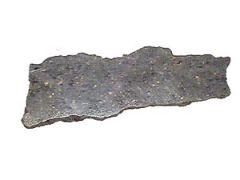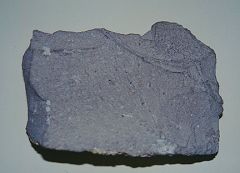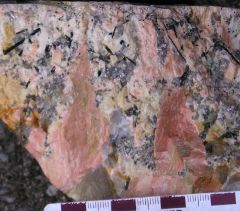![]()
![]()
![]()
Use LEFT and RIGHT arrow keys to navigate between flashcards;
Use UP and DOWN arrow keys to flip the card;
H to show hint;
A reads text to speech;
12 Cards in this Set
- Front
- Back
|
phaneritic vs. aphanitic
|
phaneritic - grains of size which can be distinguished with the naked eye
aphanitic - grains cannot be distinguihsed w/naked eye |
|
|
intrusive vs. extrusive
|
intrusive - crystallization occured very rapidly above the surface of the earth, resulting in small grain size
extrusive - crystallization occured below the surface of the earth, allowing the material to cool slowly, bigger grains |
|

|
Colour: dark grey, greenish, brownish.
Mineralogy: essential plagioclase and pyroxene, other minerals include olivine, hornblende, spinel, ilmenite, magnetite, apatite. Classification: basic plutonic igneous rock. Occurrence: deeper continental crust, widespread. Texture: course grained, granitic texture, crystals intergrown; may have lath like crystals of feldspar aligned parallel to layering. Structure: commonly layered, may show alternating light (feldspar rich) and dark (pyroxene and/or olivine) layers. |
|

|
Colour: colourless grains, also mottled in white, pink or red, some grey or dark grains.
Mineralogy: essential quartz, alkali feldspar and plagioclase in variable amounts, usually with hornblende and/or biotite; muscovite may occur. Classification: acid plutonic igneous rock. Occurrence: intrusive, most commonly occurring in batholiths. Texture: coarse to very coarse-grained; usually granular; may be porphyritic with well-shaped phenocrysts (large crystals) of feldspar; sometimes foliated; coarse intergrowths of quartz and feldspars can form a ‘graphic’ texture. |
|
|
pyroclastic?!
|
Pyroclastic means ‘fire-broken’, a name for rocks that have been blown apart by exploding gases.
|
|

|
Colour: white or grey powder when newly fallen.
Composition: ash-fall tuffs composed of a mixture of rock fragments, crystals and glass shards. Classification: pyroclastic igneous rock. Occurrence: associated with explosive volcanic activity, particle size decreases away from the vent because lighter ash is carried further by the wind. Texture: fine-grained, less than 2mm. Structure: ash-fall tuffs are often well-bedded. |
|

|
rhyolite
aphanitic kspar felsic rock quartz |
|

|
oegmatitic granite
large crystals |
|
|
porphyrytic
|
Porphyritic- Mixture of grain sizes caused by mixed cooling history; slow cooling first, followed by a period of somewhat faster cooling.
|
|
|
phenocrysts vs. groundmass
|
large crystals vs. small crystals in porphyritic rocks
|
|
|
Igneous volcanic properties
|
-numerous bubble like cavities that may or may not be lined with nminerals
-has obvious bubbly or frothy texture -is fine-grained, uniform in texture, and hard -glassy or highly vesicular rocks are almost always igneous |
|
|
igneous plutonic properties
|
made of discrete mineral grains locked together
contains large crystals in a finer grained mass rock mass obviously cuts across other rock structures |

